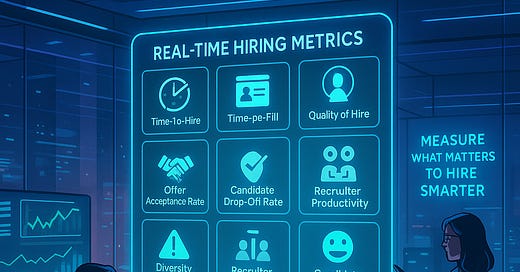Real-Time Hiring Metrics: What You Should Track and Why
In today’s ultra-competitive talent landscape, real-time hiring metrics have become indispensable for organizations aiming to attract, engage, and retain top talent. The shift from retrospective analysis to dynamic, real-time data empowers HR teams to make agile, data-driven decisions—outpacing competitors and ensuring hiring processes remain efficient and candidate-centric. Here’s an in-depth look at the most crucial real-time hiring metrics, why they matter, and how to leverage them for strategic advantage.
Why Real-Time Hiring Metrics Matter
Agility: Real-time data allows recruiters to spot and address bottlenecks instantly, reducing delays in hiring and ensuring top candidates aren’t lost to competitors.
Candidate Experience: Immediate insights into candidate touchpoints help improve transparency and responsiveness, leading to a more positive experience and stronger employer brand.
Optimization: Live metrics enable on-the-fly adjustments to sourcing strategies, job postings, and outreach, maximizing ROI and effectiveness.
Competitive Edge: Monitoring market trends and competitor activity in real time keeps your hiring strategy ahead of industry shifts.
Informed Decisions: Data-driven insights replace guesswork, guiding resource allocation, process improvements, and strategic workforce planning.
Essential Real-Time Hiring Metrics to Track
Understanding and acting on the right hiring metrics can dramatically improve the efficiency, effectiveness, and fairness of your recruitment process.
Time-to-Hire measures the number of days from when a candidate applies to when they accept an offer. It reflects process efficiency and helps spot delays or bottlenecks.
Time-to-Fill tracks the total duration from when a job is posted to when the position is filled. It provides a broader view of how long roles remain open and speaks to the overall health of your hiring process.
Cost-per-Hire captures the total costs involved in making a hire, including advertising, recruiter salaries, tools, and more. Monitoring this in real time enables budget optimization and smarter allocation of resources.
Quality of Hire evaluates the long-term success of a new hire by looking at performance, retention, and culture fit. Real-time insights here support continuous improvement in hiring standards.
Offer Acceptance Rate shows the percentage of job offers that candidates accept. A low rate may point to problems with compensation, employer branding, or the candidate experience.
Source of Hire helps you understand which recruitment channels bring in the best talent. Real-time tracking allows you to double down on what works and cut what doesn’t.
Candidate Drop-Off Rate highlights where candidates exit the recruitment process. Real-time data here allows for immediate fixes to reduce abandonment and improve flow.
Diversity Metrics track representation across gender, ethnicity, age, and other demographics. Keeping tabs on these numbers in real time helps teams stay aligned with inclusivity goals and address biases early.
Recruiter Productivity looks at how many candidates each recruiter sources, screens, and hires. This helps ensure balanced workloads and can highlight areas for training or process improvements.
Candidate Satisfaction measures how candidates perceive their experience throughout the hiring journey. Gathering feedback in real time drives better experiences and enhances your employer brand.
Pipeline Health offers a snapshot of how many qualified candidates are available at each stage of the funnel. This visibility is essential for proactive sourcing and reducing last-minute hiring scrambles.
How to Track Real-Time Hiring Metrics
1. Use Technology:
Leverage Applicant Tracking Systems (ATS), HR dashboards, and recruitment analytics software that provide instant visibility into your hiring funnel and KPIs. These tools automate data collection, visualization, and reporting, freeing teams from manual spreadsheet work.
2. Centralize Data:
Aggregate data from all sources—ATS, job boards, recruiter activities—into a single dashboard for a comprehensive, up-to-date view of recruitment performance.
3. Visualize & Benchmark:
Present data with charts and graphs for quick interpretation. Regularly benchmark your metrics against industry standards to identify gaps and areas for improvement.
4. Real-Time Feedback Loops:
Collect candidate and hiring manager feedback immediately after key stages. Use this input to adjust processes and address issues as they arise.
Best Practices for Leveraging Real-Time Metrics
Focus on Actionable KPIs: Don’t track everything—prioritize the metrics that align with your business goals and hiring challenges.
Update Regularly: Ensure dashboards and reports are refreshed in real time or as frequently as possible for relevance.
Integrate Market Intelligence: Combine internal data with external market trends, competitor analysis, and salary benchmarks for a holistic view.
Enable Predictive Analytics: Use historical and real-time data to forecast hiring needs, anticipate talent shortages, and proactively build pipelines.
QuickHire for Real-Time Hiring Success
Modern recruitment demands not just speed but precision, transparency, and adaptability. This is where QuickHire stands out as a game-changer for organizations focused on real-time hiring metrics.
QuickHire’s proprietary matching technology and mobile-first platform allow employers to monitor and optimize key hiring metrics such as time-to-hire, candidate drop-off rates, source of hire, and recruiter productivity—all from a single, intuitive dashboard. The platform’s real-time data visibility means you can instantly identify bottlenecks, adjust sourcing strategies, and ensure a healthy candidate pipeline at every stage.
Key ways QuickHire supports real-time hiring metrics:
Reduces time to hire by up to 40% through automated matching, streamlined application processes, and instant interview scheduling.
Provides a management dashboard with real-time insights across multiple locations, giving you up-to-the-minute data on your hiring funnel and candidate flow.
Tracks candidate engagement and drop-off with built-in analytics, enabling immediate process improvements.
Boosts offer acceptance and retention rates by ensuring candidates are well-matched and engaged throughout the process—QuickHire talent stays 3x longer than the industry average.
Automates reminders and communications to reduce no-shows and improve candidate experience, further enhancing key metrics like candidate satisfaction and pipeline health.
With QuickHire, you’re not just filling positions—you’re building a smarter, more responsive hiring process that leverages real-time metrics for continuous improvement and competitive advantage.
Ready to transform your hiring strategy? The future of recruitment is real-time—how will you harness these metrics to build your winning team?






